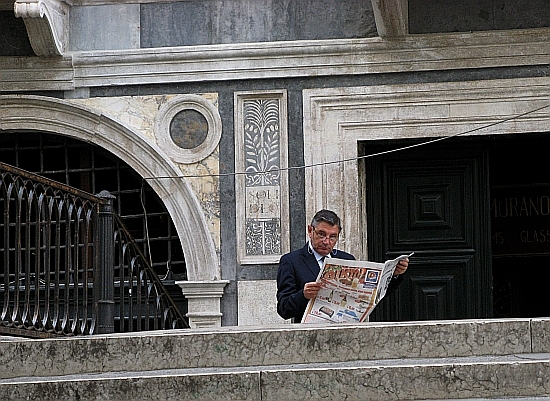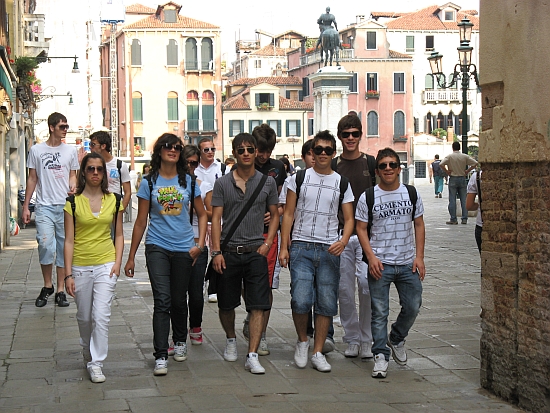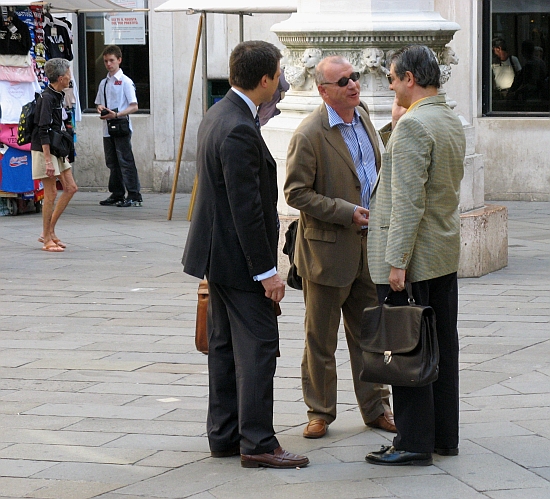
Venice meets New York


Whenever I find myself with some Venetian for the first time, and for whatever reason I mention that I used to live in New York, the person almost always seems slightly startled, then makes some remark along the lines of “Boy, Venice must seem really small/different/strange/minuscule/quarklike” to you.
At first glance, it might in fact seem that the fabled Large Malus domestica (pop. 8,175,133 and growing) would have nothing at all in common with the equally fabled Most Serene Republic (at the moment down to 60,052 and shrinking).

But I have always felt right at home here, because — as I tell the person, startling her or him even more — there is an amazing number of ways in which Venice and New York appear to be like those twins that get separated five minutes after birth and years later turn up to have both married women named Clotilde on the same day and have vacation cabins on Lake Muskoka.
Speaking of twins, I’ve never quite understood that whole business of twinning cities. Not because I don’t grasp that both partners desire thereby to undertake commercial adventures together, but because the partnerships often seem so odd.
The other places are frequently the same grade of innocuous as the one you’re entering, which makes sense, I suppose. I mean, you’d never see “Toad Suck/Beijing.” Naturally there are exceptions to what seems like an obvious rule; Rome/Paris makes sense, but Rome/Multan, Pakistan is a bit more obscure. Or there are less glamorous but equally curious combinations (Seattle/Tashkent), on down to the level of Torviscosa/Champ-sur-Drac. Well, as long as they’re happy.
Venice has formally twinned itself with 15 cities; the link is fairly clear with St. Petersburg (seaport cities with canals), though the link with Islamabad is a bit harder to discern. It might have been clever (only to me, of course) to have twinned Venice with every town named Venice, or which bills itself as “the Venice of” wherever it is.
There are 19 “Venice of the North”s, and a remarkable amount of so-called “Venice of the such-and-such” strewn around the world at other compass points: South (Johannesburg; Tawi-Tawi island), East (Alappuzha, India; Bangkok; Melaka River, Malaysia), China (Wuzhen), and so on. There are four American towns named Venice, one each in Florida, California, Illinois, Utah. (Venetia, Pennsylvania, doesn’t count, though I give it special points for historical interest.) Surprisingly, there are many more towns in the US named Verona.

Back to the Ur-Venice and its resemblance to New York. I’ve made a little hobby of collecting points of similarity, as I come across them, and in no particular order, here are some of the most obvious examples:
* They are both seaport cities.
* They are (or have been) economic colossi. The wealth of Venice was something inconceivable today, unless we’re thinking of that tiny top percentage of people who own everything. Not long ago an Indian tycoon staged his daughter’s wedding here; it went on for three days and cost, it was reported, something like 10 million euros ($14 million). He would have fit right in with the Pisanis and Corners (and Rockefellers and Carnegies.)
* They both have a long history of many coexisting (more or less happily) ethnic communities.
* Housing/real estate is a major issue, both regarding cost (exorbitant) and space (cramped). In either city you can as safely launch a conversation with a stranger on the problems of housing as you can on the weather.
* They are both populated by complainers; not the ordinary type, but those special inhabitants who belong to the category in which, according to the famous quip about New Yorkers, “Everybody mutinies but nobody deserts.”

* Everybody notices each other and plenty of things about each other, though it may not seem so. The minute you step into the subway train, everybody will have evaluated you in a hundred instant ways, starting with your potential for being dangerous and ending (perhaps) with your choice of shoes. I thought I was invisible here in the early days, which Lino thought was hilarious. I’d only been here a week when he said, “Everybody already knows everything about you.” I let that slide, till one day I ran into one of the few people I knew, who lived far away on the Giudecca. “I saw you rowing in the caorlina last Saturday afternoon,” he told me. It seemed like a friendly remark, except that having been seen by somebody I hadn’t seen at all gave me a tiny shudder. And made me realize that nobody is invisible here, and never has been.
* Pride: New Yorkers refer to themselves as living in “The City”; no need for further identification. With many more centuries of experience at this, Venetians by now don’t even do that. It’s so obvious that being Venetian is the best that there is no need to mention it.
I realized this the day I struck up a conversation in Rimini with a couple who said they were from Venice. I asked the normal follow-up question: “Oh? Where do you live?” (As in: Cannaregio, Campo Ruga, near the Accademia, etc.) A split second of hesitation, and the wife answered, “We live in Castelfranco Veneto.” Castelfranco Veneto is a small town (pop. 33,707) 40 miles/64 km from Venice.
Here’s the thing: I knew they didn’t live in Venice by the faintly self-satisfied way in which they had said it. People in Venice don’t say it that way, just as New Yorkers don’t brag about living in New York. If you live there, you already know you’re in the best place in the world; there’s no need to rivet exclamation points all around it.
* They’re not for everybody. This is the strongest link of all between the two cities. Living in either city is a vocation, a calling, a challenge, a Zen conundrum. Living here, as in New York, requires a complex combination of skills (physical, emotional, intellectual) and predilections (history, humor, remembering the names of people’s children) that frankly don’t suit everybody.

“It’s great to visit, but I could never live here,” almost everybody says about New York. I’ve almost never heard it said of Venice, though it’s not unusual to hear someone say “It must be so wonderful to live here.” Tourists have been so brainwashed by publicity and postcards that they don’t believe it’s real and don’t even want it to be. And they’re here for so short a time, they don’t usually have the chance to be disillusioned, unless something bad happens.
That, probably, is one of the main mileposts at which Venice and New York diverge. Things go wrong in New York (barring homicide, etc.) and visitors regard it as either inevitable or picturesque, the stuff of stories forever. If something goes wrong here, people get mad, as if they’d been baited-and-switched.
No bait here.
